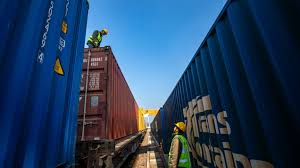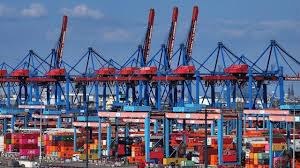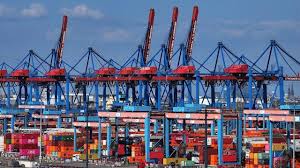Risk and reward: Why the EU should develop the Middle Corridor trade route

The EU’s plans to upgrade the Middle Corridor trade route may boost Russian and Chinese connectivity with central Asia. But for Europeans, the long-term economic and strategic benefits of going ahead with the development far outweigh these risks
Before the war in Ukraine, 86 per cent of land trade between Europe and China transited through Russia along the so-called Northern Route, a set of railways extending from China’s northern border to Belarus and the European mainland. But European sanctions against Moscow have made the route much less attractive for global trade, and depending on Russian infrastructure and railway services to import goods from China is a strategic vulnerability that Europe is keen to get rid of.
Instead, the European Union is hoping to reduce its reliance on Russian territory by leading the development of a shorter alternative route through central Asia, called the Trans-Caspian International Transport Route (TITR). Better known as the Middle Corridor, the TITR is a network of transport routes that replicates the ancient Silk Road, extending from China to Europe across Kazakhstan, the Caspian Sea, and the Caucasus into Turkey.
Operational since 2017, the Middle Corridor is a multimodal transport system relying mostly on existing basic rail and port infrastructure. Last year, it handled just 2.3 million tonnes of cargo. But forecasts by the World Bank indicate that with significant infrastructural upgrades this volume could reach 11 million tonnes by 2030. To make sure this happens, the EU has already allocated €10 billion to related infrastructure through its Global Gateway initiative and is considering expanding its involvement. However, while it may largely avoid Russia, this transport route comes with its own strategic challenges.
Moscow can still partly benefit from its development by diverting some of its goods along the Middle Corridor to protect them against Ukrainian attacks on Siberian railways or to circumvent sanctions and export controls – something which is already happening through central Asian economies. On top of this, Russia could link up the Middle Corridor with the planned International North-South Transport Corridor, a connectivity project with Iran and Azerbaijan, which would help Russian trade reach the Indian Ocean.
Despite the EU wanting to develop the Middle Corridor precisely to avoid Russia, it may end up indirectly helping Russia’s international connectivity. Alongside this, the Middle Corridor may also assist China’s influence in the region by allowing China to expand its economic engagements further west across the steppes, nor would the corridor necessarily reduce Europe’s problematic dependence on China, running in apparent contrast with EU de-risking ambitions.
Notwithstanding these challenges, the benefits of developing the Middle Corridor still outweigh the risks, largely due to its potential to deepen European connections with central Asia. Already, the region is beginning to pique Chinese and European interest, benefitting from its strategic position between Europe and east Asia, vast resource endowment (especially gas, oil, and minerals), and renewable energy potential.
This comes on top of existing Russian influence in the region, which Moscow facilitates through the Eurasian Economic Union. In such a contested region, the powers able to provide China-Europe connectivity through it stand to gain significant geoeconomic influence. Europeans can rest assured that if they do not throw their weight behind the project, someone else will.
Europeans can rest assured that if they do not throw their weight behind the Middle Corridor project, someone else will
For central Asian countries, moves to reignite their heritage as an essential trading route could not come at a better time: the former soviet republics are keen to diversify their economies and reach out to new trade partners – a desire that has intensified since Russia’s invasion of Ukraine. At the same time, Russia now relies on these republics as both customers and transit countries for the gas it can no longer sell on the European market.
While Moscow’s sales of cheap energy to central Asian countries is an offer they cannot possibly refuse, being exclusively linked to fossils fuel means this influence will not last beyond the short term. At the same time, central Asian capitals are equally wary of excessive reliance on China, as the promised benefits of the Belt and Road Initiative have materialised only partially, and China is also increasingly seen as a threat due to high debts owed to Beijing. For central Asian governments, the Middle Corridor development would therefore allows them to future-proof their economies, reducing dependence on fossil fuels, as well as on Russia and China.
The EU should leverage central Asia’s desire for the Middle Corridor development. While most transport infrastructure runs the risk of being used by rival powers (the ambitious India-Middle East-Europe Corridor (IMEC) could also be used by China once established), the greatest return is the clout for the power that builds it. The consensus behind the corridor is growing and China remains active on this front, making this a geoeconomic game the EU can hardly afford to leave.
Moreover, going forward with the Middle Corridor development would help Europeans face another inconvenient truth: trade with China is not disappearing or declining anytime soon, and reducing reliance on Beijing for key technologies would hardly mean a slump in overall trade. Goods would continue to move over land between Europe and China and the Middle Corridor would make sure that some of them would not transit through Russia. There is no prospect of economic engagement between Russia and Europe returning to pre-war levels. Constructing a route bypassing Russia would serve the EU’s structural goals far more than reducing all trade with China could.
By providing much-needed regional connectivity and developing the Middle Corridor, the EU has the chance to position itself as a major geoeconomic player in the region, leveraging the central Asian concerns over Chinese and Russian approaches. Alongside the EU’s already allocated €10 billion for infrastructure, its engagement should go beyond transportation. The Middle Corridor would be most successful if it became a true economic corridor, including energy and industrial activities alongside the transport route, providing real added value to local economies. Europe should therefore expand existing energy partnerships, like the one with Kazakhstan, with greater focus on the region’s renewable potential: greening central Asian economies would reduce their demand for Russian gas or electricity, containing Moscow’s efforts. More than that, as the corridor is expected to account mostly for trade between central Asian countries (the share of transcontinental trade would remain below 40 per cent even in 2030), fears of China free-riding on European-built infrastructure may be exaggerated. Additionally, to make the most of the Middle Corridor development, the EU should accompany infrastructural investment with the offer of broader economic engagement that would allow countries along the corridor to participate in European value chains. This would turn the Middle Corridor from an avenue for EU-China land trade into a potential de-risking enabler for Europe by replacing some Chinese trade with that of central Asian economies.
While these partnerships would take time to be constructed, the EU can – and should – use the Middle Corridor as leverage on two fronts. The first one is internal to the region: despite being worried about central Asian countries circumventing sanctions against Russia, the European Commission has so far refrained from using a dedicated tool, preferring diplomatic engagement. Here, linking Middle Corridor investments to compliance with EU export controls could improve the bloc’s negotiating position. The second external front is the Turkish one: President Recep Tayyip Erdogan has sharply criticised the exclusion of Turkey from IMEC. As the natural entry point of the Middle Corridor into Europe, Turkey stands to benefit from its development. Europeans should therefore use it to reassure Ankara that it would still continue to play a primary role in EU external connectivity. In doing so, they would gain an ally in Turkey for the EU’s Middle Corridor ambitions and subsequent partnership with central Asian countries.
The development of the Middle Corridor faces risks that the EU should carefully address. But this should not hold Europeans back from tapping into its geoeconomic value. Brussels should focus on the huge potential that the corridor’s development could bring in terms of deepening economic, political, and energy ties with central Asia. At the same time, while China and Russia may benefit from increased connectivity in the region, Europe’s newfound central Asian partnerships may well contain these rival influences far more than the corridor would help them.





